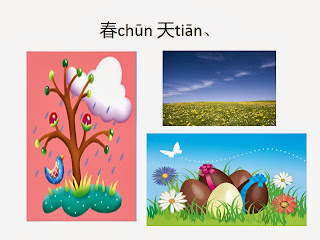For Chinese Level I students. We reviewed the numbers 1-100 in Chinese. We first copy down the numbers in Chinese characters; the teacher explained the Chinese numbers rules, and then we watched a powerpoint related to numbers and played the big wheel.
Later we sang the song about "找朋友“。
Click the link to watch the teacher singing "找朋友“
https://docs.google.com/file/d/0BykK4J3trllPX2tzRUxIWHFMdE0/edit?usp=sharing
Click the link to watch a group of students singing "找朋友”
https://docs.google.com/file/d/0BykK4J3trllPRHFic1MxajdqSE0/edit?usp=sharing
Click the link to watch the powerpoint
https://docs.google.com/file/d/0BykK4J3trllPeTVDdWh4MXBocTg/edit?usp=sharing
Game One = Throwing Dice.
We played about 10-15 minutes throwing dice and yelling aloud the numbers in Chinese.
1. Group students into 4 or 5 of groups.
2. Give students two dices with different colors. They in the group may decide which dice presents the digit in 10, and which presents the digit in 1.
3. A recorder in each group is assigned to record who is the fastest one yelling aloud the numbers in Chinese and receive a point each time.
4. Each member in the group takes turn to throw the dices and the dots on the dices presents numbers and students who yell aloud the numbers in Chinese receive a point.
We also played "去釣魚“ (Go Fish) in Chinese for 10 minutes. You may click the video link to see how the students enjoy the game.
https://docs.google.com/file/d/0BykK4J3trllPZFIwVWZjcTBzSjA/edit?usp=sharing
1. Group students into 3 or 4 of groups.
2, Give students a pack of poker cards.
3. Teach students the following phrase first,
你有沒有
….= Do you have…?
有。= Yes, I do (have it).
沒有。=
No, I don’t (have it).
去釣魚 = Go Fish
How to play "Go Fish"...
1.
Go Fish is best for 3-6 players, but it
is possible for 2 to play. A standard 52 card deck is used.
2.
The dealer deals 5 cards to each player
(7 each for 2 players). The remaining cards are placed face down to form a
stock.
3.
The player to dealer's left starts. A
turn consists of asking a specific player for a specific rank. For example, if
it is my turn I might say: 'Mary, please give me your jacks'. The player who
asks must already hold at least one card of the requested rank, so I must hold
at least one jack to say this. If the player who was asked (Mary) has cards of
the named rank (jacks in this case), she must give all
her cards of this rank to the player who asked for them. That player then gets
another turn and may again ask any player for any rank already held by the
asker.
4.
If the person asked does not have any
cards of the named rank, they say 'Go fish!'. The asker must then draw the top
card of the undealt stock. If the drawn card is the rank asked for, the asker
shows it and gets another turn. If the drawn card is not the rank asked for,
the asker keeps it, but the turn now passes to the player who said 'Go fish!'.
5.
As soon as a player collects a book of
4 cards of the same rank, this must be shown and discarded face down. The game
continues until either someone has no cards left in their hand or the stock
runs out.
For Chinese Level II & III, we first reviewed the words and sentence patterns, then we acted out a story. After the acting out, we watched a powerpoint. With the powerpoint we also used TPRStorytelling circling questions to practice listening and speaking. Later students worked as pairs and to work on the fill-in blank story sheet. Last we played Bingo game to review the clothing and colors words.
I tried to video this class while we were doing TPRStorytelling but accidentally clicked photo instead of video. Too bad because I was pretty amazed students' creativity to make their own sentences. While we asked "爲什麽?“, students had to answer in a full sentence start with "因爲“
Click the link to read
the story (article) and the fill-in blank story
https://docs.google.com/file/d/0BykK4J3trllPcDJqaDdWdU0wS2s/edit?usp=sharing
Click the link to watch
the powerpoint
https://docs.google.com/file/d/0BykK4J3trllPajhUVW85LUJlemc/edit?usp=sharing
We also learned the following words..
冬天 =
winter
夏天= summer
春天 =
spring
秋天= fall
很冷 = very
cold
很熱
= very hot
很涼爽= very cool
很溫暖= very warm
去 = to go (to)
商店 = store

















